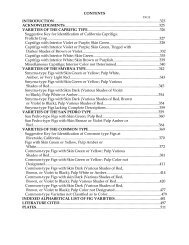Figs in the Home Garden I General Information - Figs 4 Fun
Figs in the Home Garden I General Information - Figs 4 Fun
Figs in the Home Garden I General Information - Figs 4 Fun
You also want an ePaper? Increase the reach of your titles
YUMPU automatically turns print PDFs into web optimized ePapers that Google loves.
If Plants Could Talk: Fact Sheets: <strong>Figs</strong> <strong>in</strong> <strong>the</strong> <strong>Home</strong> <strong>Garden</strong> I <strong>General</strong> <strong>Information</strong><br />
Fact Sheets<br />
FS188<br />
Virtual Tour<br />
<strong>Figs</strong> <strong>in</strong> <strong>the</strong> <strong>Home</strong> <strong>Garden</strong> I <strong>General</strong> <strong>Information</strong><br />
DJ. Anthony Hopf<strong>in</strong>ger<br />
Specialist <strong>in</strong> pomology<br />
The fig is sometimes called a "fruit without a flower." It does have flowers, however, that are borne on <strong>the</strong> <strong>in</strong>side of <strong>the</strong><br />
fruit. Most fig varieties yield two dist<strong>in</strong>ct crops of fruit each year. The first crop (breba) is produced on <strong>the</strong> previous year's<br />
shoot growth; <strong>the</strong> second crop is borne <strong>in</strong> <strong>the</strong> leaf axils (where <strong>the</strong> leaf attaches to <strong>the</strong> stem) of <strong>the</strong> current season's<br />
growth. Mission, Kadota, and Osborn varieties yield both breba and second-crop figs. O<strong>the</strong>r varieties, such as Brown<br />
Turkey, Adriatic, and Smyrna produce ma<strong>in</strong>ly second-crop figs. The amount of prun<strong>in</strong>g can affect <strong>the</strong> quantity of <strong>the</strong> fruit,<br />
whe<strong>the</strong>r first- or second-crop figs. For example, severe prun<strong>in</strong>g often practiced on Kadota figs, grown primarily for<br />
cann<strong>in</strong>g, drastically reduces <strong>the</strong> amount of breba (first crop). In New Jersey, if <strong>the</strong> trees are not wrapped or o<strong>the</strong>rwise<br />
<strong>in</strong>sulated or sheltered <strong>in</strong> w<strong>in</strong>ter, fruit buds on <strong>the</strong> previous season's growth will be killed.<br />
Remember, figs are subtropical <strong>in</strong> orig<strong>in</strong> and thrive <strong>in</strong> areas where w<strong>in</strong>ter temperatures do not drop below 15° F. Young<br />
trees can be damaged by early fall frosts when <strong>the</strong> temperature is 25-27o F. One problem <strong>in</strong> New Jersey is that frost<br />
usually kills <strong>the</strong> second or late season figs before <strong>the</strong>y fully mature. Fig trees grow well <strong>in</strong> a variety of soils rang<strong>in</strong>g from<br />
sandy loams to clay loams.<br />
Consideration of <strong>the</strong> four types of figs is needed to expla<strong>in</strong> <strong>the</strong> more common reasons for <strong>the</strong> failure of some trees to set<br />
and mature fruit.<br />
CAPRIFIGS - usually <strong>in</strong>edible and are commonly known as male figs because of <strong>the</strong>ir pollen-bear<strong>in</strong>g flowers. A small wasp<br />
will <strong>in</strong>vade this fig, and carry pollen to o<strong>the</strong>r figs to achieve poll<strong>in</strong>ation. This <strong>in</strong>sect, responsible for poll<strong>in</strong>ation, is not<br />
found <strong>in</strong> New Jersey due to cold w<strong>in</strong>ter temperatures.<br />
SMYRNA TYPE - absolutely requires <strong>the</strong> stimulus of caprification for <strong>the</strong> fruit to set and mature. The Calimyrna fig is of<br />
this type. <strong>Figs</strong> such as Calimyrna should not be planted <strong>in</strong> backyards because of <strong>the</strong> difficulty <strong>in</strong> obta<strong>in</strong><strong>in</strong>g caprifigs<br />
conta<strong>in</strong><strong>in</strong>g fig wasps at <strong>the</strong> right time to achieve poll<strong>in</strong>ation.<br />
SAN PEDRO TYPE - so-called because it <strong>in</strong>cludes <strong>the</strong> White San Pedro. Trees of this type set and mature figs on wood of<br />
<strong>the</strong> previous season with poll<strong>in</strong>ation of flowers. <strong>Figs</strong> appear<strong>in</strong>g later <strong>in</strong> <strong>the</strong> season <strong>in</strong> <strong>the</strong> axils of <strong>the</strong> leaves (where leaf<br />
attaches to stem), on <strong>the</strong> same branches, will drop unless caprification takes place.<br />
COMMON TYPE - sets and matures one or two crops of figs without caprification. First crop (breba) are generally few <strong>in</strong><br />
number, but larger than figs of <strong>the</strong> second crop.<br />
FIG VARIETIES<br />
Common type<br />
Panache - A French fig occasionally found <strong>in</strong> backyards and noteworthy because of its green and yellow striped fruit. <strong>Figs</strong><br />
are medium <strong>in</strong> size, yellow when mature, with a strawberry colored pulp. Fair quality.<br />
Marseilles - Grown <strong>in</strong> coastal sections of California for more than 75 years; sometimes known as White Smyrna. <strong>Figs</strong> of two<br />
crops are similar <strong>in</strong> character, medium, green, with white pulp and large prom<strong>in</strong>ent seeds. Good quality.<br />
Kadota - Commonly has two crops. Brebas are above medium to large, green with violet, and light strawberry pulp.<br />
Second-crop figs are medium, green to yellow, with white meat and amber pulp, almost seedless. Very unsatisfactory as a<br />
http://web.archive.org/web/20040926171825/http://...tgers.edu/factsheets/factsheet.asp?fsnumber=FS188 (1 of 2) [6/5/2009 10:25:47 PM]
If Plants Could Talk: Fact Sheets: <strong>Figs</strong> <strong>in</strong> <strong>the</strong> <strong>Home</strong> <strong>Garden</strong> I <strong>General</strong> <strong>Information</strong><br />
backyard tree, with fruit dropp<strong>in</strong>g badly or shrivel<strong>in</strong>g before maturity. Not recommended for home gardens.<br />
Adriatic - One of <strong>the</strong> pr<strong>in</strong>cipal figs used <strong>in</strong> dry<strong>in</strong>g. Breba crop is very light and has large, green fruit with red-blood pulp.<br />
Second-crop figs are medium, green, and often have p<strong>in</strong>k or amber pulp. Good quality.<br />
Brown Turkey - Extensively planted <strong>in</strong> hot <strong>in</strong>terior valleys of sou<strong>the</strong>rn California and known for its heavy production of<br />
large figs. The breba crop is light with large, purple figs. Second-crop figs are large, greenish to purple with a hollow<br />
center, and p<strong>in</strong>k pulp. Excellent quality when ripened on <strong>the</strong> tree.<br />
Mission - Planted <strong>in</strong> coastal areas on <strong>the</strong> west coast. The breba crop is large, purplish-black, with p<strong>in</strong>k pulp. Second-crop<br />
figs are medium, also purplish-black, with p<strong>in</strong>k pulp. Excellent quality. This variety tends to have figs when o<strong>the</strong>rs do not<br />
produce.<br />
Celeste - Widely grown <strong>in</strong> Louisiana and o<strong>the</strong>r Sou<strong>the</strong>rn States. No breba crop. Second-crop figs are small, pear-shaped<br />
with a long stock, brown to violet, with p<strong>in</strong>k pulp. Good quality. Trees are not common, but generally productive.<br />
Consider<strong>in</strong>g all of <strong>the</strong> figs mentioned, Brown Turkey and Celeste would be <strong>the</strong> recommended varieties for New Jersey<br />
backyards. The primary reason is that <strong>the</strong>se varieties do not require poll<strong>in</strong>ation to produce fruit. Brown Turkey is also<br />
recommended because it matures <strong>the</strong> second crop of figs earlier <strong>in</strong> <strong>the</strong> season than o<strong>the</strong>r varieties mentioned.<br />
Many homeowners have fig trees that ei<strong>the</strong>r do not bear fruit or <strong>the</strong> fruit develops to <strong>the</strong> size of a quarter and falls off, or<br />
<strong>the</strong> fruit does not mature before <strong>the</strong> first hard frost <strong>in</strong> <strong>the</strong> fall. For fur<strong>the</strong>r <strong>in</strong>formation see FS189 "FIGS IN THE HOME<br />
GARDEN II: Culture and Management Problems."<br />
Rutgers Cooperative Extension is an Equal Opportunity Program Provider and Employer<br />
If Plants Could Talk, Copyright © 1997-2004<br />
Last modified Wednesday, January 21, 2004<br />
by Sean S. Convery<br />
http://web.archive.org/web/20040926171825/http://...tgers.edu/factsheets/factsheet.asp?fsnumber=FS188 (2 of 2) [6/5/2009 10:25:47 PM]

















![Fig Trees in North Carolina [Archive] - IDigMyGarden ... - Figs 4 Fun](https://img.yumpu.com/26905320/1/190x245/fig-trees-in-north-carolina-archive-idigmygarden-figs-4-fun.jpg?quality=85)